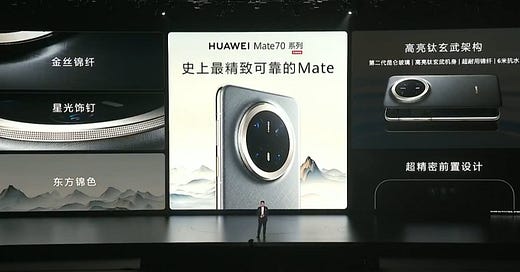On November 26, 2024, Huawei unveiled its latest flagship smartphone lineup, the Mate 70 series, marking a significant stride in the company's pursuit of technological independence amid ongoing U.S. sanctions. The series comprises four models: Mate 70, Mate 70 Pro, Mate 70 Pro+, and Mate 70 RS Ultimate Design, each showcasing Huawei's advancements in hardware and software development.
HarmonyOS NEXT: A Leap Towards Software Autonomy
A standout feature of the Mate 70 series is the integration of HarmonyOS NEXT, Huawei's self-developed operating system that operates independently of Google's Android platform. This move underscores Huawei's commitment to reducing reliance on U.S. technology and fostering a self-sustaining software ecosystem. HarmonyOS NEXT introduces a refined user interface, enhanced animations, and improved connectivity across Huawei devices. Notably, it incorporates generative AI capabilities and a Large Language Model (LLM) to enhance the voice assistant and provide advanced image and video editing tools.
Kirin 9020 Chip: Pioneering In-House Processing Power
The Mate 70 Pro, Pro+, and RS models debut Huawei's new Kirin 9020 chip, a 12-core processor featuring two 2.5GHz high-performance cores, six 2.15GHz mid-performance cores, and four 1.6GHz efficiency cores. This configuration positions the Kirin 9020 as a competitor to Qualcomm's Snapdragon 8+ Gen 1, delivering substantial performance enhancements over previous models. The standard Mate 70 model is equipped with the Kirin 9010 chip.
Design and Display: Merging Aesthetics with Functionality
The Mate 70 series features a redesigned rear camera module, prominently encased within a large circular housing that adds a distinctive aesthetic appeal. The Pro models boast a 6.9-inch OLED LTPO display with a 1-120Hz adaptive refresh rate, offering a seamless visual experience. The standard Mate 70 comes with a 6.7-inch flat display, catering to users who prefer a more traditional screen design.
Camera System: Elevating Mobile Photography
Huawei continues its focus on camera innovation with the Mate 70 series. The devices are equipped with a 50MP main sensor, complemented by a 48MP telephoto lens and a 40MP ultra-wide-angle lens. This versatile setup supports 4K videography, night mode, and variable aperture photography, enabling users to capture high-quality images across various lighting conditions. The integration of Huawei's in-house XMAGE imaging system further enhances image processing capabilities.
Battery and Charging: Powering Extended Use
The Mate 70 Pro and Pro+ models are powered by a 5,700mAh battery, an upgrade from the 5,000mAh battery in the previous generation. These devices support 100W wired charging and 88W wireless charging, ensuring rapid power replenishment. The standard Mate 70 features a 5,300mAh battery with 66W wired and 50W wireless charging capabilities.
Market Positioning and Strategic Implications
The launch of the Mate 70 series signifies Huawei's resilience and adaptability in the face of stringent U.S. sanctions that have limited its access to critical technologies. By developing proprietary hardware and software solutions, Huawei aims to solidify its position in the premium smartphone market and reduce dependency on foreign technology. This strategic shift reflects a broader trend of technological self-reliance within China's tech industry.
Conclusion
Huawei's Mate 70 series represents a pivotal advancement in the company's journey toward technological independence. With the integration of HarmonyOS NEXT and the Kirin 9020 chip, Huawei demonstrates its capability to innovate and compete at the highest levels of the smartphone industry, despite external challenges. The Mate 70 series not only offers consumers a suite of high-performance devices but also underscores Huawei's commitment to pioneering a self-sufficient technological ecosystem.





